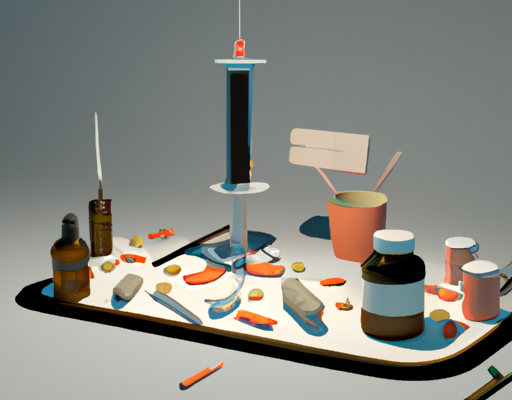Background
Type 1 and Type 2 diabetes are two of the most common forms of diabetes. Type 1 diabetes, also known as juvenile diabetes, is an autoimmune disorder in which the body does not produce insulin, a hormone required to break down and absorb glucose, or sugar, from the food we eat. Type 2 diabetes is a metabolic disorder in which the body cannot produce enough insulin or cannot effectively use insulin, which again, affects the absorption of glucose into the body. It is important to understand the differences between Type 1 and Type 2 diabetes and the risk factors for each.
Health – Background:
- Type 1 diabetes is an autoimmune disorder in which the body does not produce insulin
- Type 2 diabetes is a metabolic disorder in which the body cannot produce enough insulin or cannot effectively use insulin
- Risk factors for Type 1 diabetes include family history, ethnicity, and exposure to certain viral infections
- Risk factors for Type 2 diabetes include being overweight, leading a sedentary lifestyle, and having a family history of the disease
- Type 1 diabetes does not turn into Type 2 diabetes.
Definition of Type 1 Diabetes
Type 1 diabetes, also known as juvenile diabetes, is an autoimmune disorder. It is a chronic condition that occurs when the pancreas produces very little or no insulin. Without sufficient insulin, the body is unable to process food efficiently, resulting in a dangerous buildup of glucose in the bloodstream. The risk of developing type 1 diabetes is greater in children and young adults, and it is most commonly diagnosed before the age of 30. It is typically managed with insulin injections, diet and lifestyle changes, and careful monitoring of blood sugar levels. Left untreated, it can lead to serious complications, including heart disease, nerve damage, kidney damage and blindness.
Definition of Type 2 Diabetes
Type 2 diabetes is an illness that affects millions of people around the world and is characterized by elevated blood sugar levels due to your body’s inability to produce a sufficient amount of insulin. This type of diabetes is caused when cells in the body become resistant to the insulin hormone, causing the body’s blood sugar levels to become too high. In some cases, type 2 diabetes can be controlled through lifestyle choices such as diet and exercise, while in other cases medical intervention may be needed to manage it. In severe cases, complications can arise, such as kidney and nerve damage, heart attack, stroke, and blindness. The key to managing type 2 diabetes is to maintain a healthy lifestyle that includes a balanced diet, regular physical activity, and monitoring your blood sugar levels. With early and consistent intervention, life with diabetes can still be enjoyed and lived to its fullest potential.
Risk Factors
Type 1 diabetes is an autoimmune disease in which the body’s immune system mistakenly attacks and destroys the cells in the pancreas that make insulin. Type 1 diabetes is usually diagnosed in children and young adults, and it is thought to be caused by a combination of genetic and environmental factors. Type 2 diabetes, on the other hand, is a metabolic disorder in which the body is unable to properly use insulin or produce enough of it. It is usually diagnosed in adults, and is linked to lifestyle factors such as being overweight or obese and living an inactive lifestyle. While it is possible for someone with type 1 diabetes to develop type 2 diabetes, it is rare and is only seen in a small number of cases. Risk factors for developing type 2 diabetes include being overweight or obese, having high blood pressure, having a family history of diabetes, being of African, Asian, or Hispanic descent, and being over the age of 45. Additionally, having gestational diabetes puts women at higher risk of developing type 2 diabetes later in life.
Causes
Type 1 diabetes, also known as juvenile diabetes, is an autoimmune disorder triggered by the body’s own immune system attacking and destroying the cells in the pancreas responsible for producing insulin. Although the exact cause of type 1 diabetes is not fully understood, the condition is believed to be the result of genetic, environmental or other factors. Genes play an important role, but there is no one single gene responsible. Infections and other illnesses, such as the cowpox virus, may also play a part in triggering type 1 diabetes. Other possible causes include a diet low in Vitamin D, exposure to certain chemicals, or even being born too large (macrosomia).The likelihood of type 1 diabetes turning into type 2 is incredibly rare, as these two conditions have different causes and treatments. However, those with type 1 diabetes may be at a higher risk of developing type 2 later in life, if their blood glucose levels are poorly managed. While type 1 diabetes is an autoimmune disorder, type 2 is usually the result of lifestyle factors, such as poor diet and lack of exercise. As with all conditions, prevention is key and individuals with type 1 diabetes should do their best to maintain a healthy lifestyle to try and reduce their risk.
Genetics
Type 1 and type 2 diabetes are two very different conditions that develop in different ways. The determining factor between these two types of diabetes is the difference in the way the body processes insulin.
- Type 1 diabetes is an autoimmune disorder in which the body fails to produce enough insulin.
- Type 2 diabetes is a metabolic disorder characterized by the body’s inability to process glucose properly.
- There is a clear genetic factor involved in the development of type 1 diabetes.
- Type 2 diabetes often has a genetic basis, but environmental and lifestyle factors also play a role.
Type 1 diabetes generally occurs in childhood, but it can occur at any age. Type 2 diabetes tends to develop in adulthood, and it is strongly linked to lifestyle factors like obesity, lack of exercise, and a poor diet. Both types of diabetes require daily management and careful monitoring of blood sugar levels. While type 1 diabetes cannot be prevented, type 2 diabetes can be managed through lifestyle changes and medical therapy.
Methods of Prevention
When it comes to preventing the onset of Type 1 diabetes, the most important tactic is to maintain a healthy lifestyle. Eating a healthy diet with plenty of fruits, vegetables, lean proteins and whole grains, while avoiding added sugars and unhealthy fats, is essential in minimizing your risk of developing diabetes. Additionally, getting plenty of moderate physical activity throughout the week and maintaining a healthy weight can be beneficial in preventing diabetes. Receiving regular check-ups with your doctor can be key in tracking your blood sugar levels and staying informed of any early signs of diabetes. If you have a family history of diabetes, it is important to talk to your doctor to discuss strategies to reduce your risk of developing the condition as well. Finally, regular screenings and testing your blood sugar levels can help to identify any early signs of diabetes, allowing you to take the necessary steps to prevent or delay the onset of the condition.
Treatment
Diabetes is a complex health condition that affects millions of people of all ages around the world. Although both type 1 and type 2 diabetes share the same common symptoms, they are two totally different conditions, and the two cannot be confused. Treatment for both types of diabetes is essential to manage the disease and lead a healthy life. Here is a list of steps people with either type 1 or type 2 diabetes should take:
- Maintain a healthy diet by eating lots of fruits and vegetables and avoiding foods that are high in sugar.
- Try to exercise regularly to help keep blood sugar levels in check.
- Monitor your blood sugar levels using a glucometer.
- Take prescribed medications and insulin regularly to keep your blood sugar levels stable.
- See your doctor regularly to review your treatment plan and make any necessary changes.
It is important to note that type 1 diabetes cannot turn into type 2 diabetes, as the two conditions are totally different. However, people with type 1 diabetes should take the same preventative measures as those with type 2 diabetes to stay healthy. By following the steps mentioned above, people with either type of diabetes can stay on top of their condition and keep blood sugar levels under control.
Outlook
Type 1 diabetes is considered an autoimmune disorder and is usually diagnosed during childhood. While type 1 diabetes is not reversible, it can be managed with a variety of treatments. On the other hand, type 2 diabetes usually develops during adulthood and can sometimes be reversed with lifestyle modifications. It is important to note that type 1 diabetes will not turn into type 2 diabetes. However, people with type 1 diabetes are at an increased risk of developing type 2 diabetes as they age and progress through life. The outlook for people with type 1 diabetes is good with consistent management and vigilant medical care. People with type 1 diabetes can live full and productive lives, and may even go into remission if the disease is managed successfully.
Conclusion
Conclusion: The prognosis for Type 1 diabetes is generally very good if individuals adhere to their prescribed meal plans, exercise routines, and medication regiments. To ensure positive long-term health outcomes, it is important for individuals with Type 1 diabetes to:
- Eat a healthy, well-rounded diet
- Maintain an active lifestyle
- Monitor their blood sugar levels daily and adjust dosages as needed
- Regularly visit a physician and report any changes
Ultimately, it is highly unlikely that Type 1 diabetes will turn into Type 2 diabetes. Although there are some similarities between the two types of diabetes, they are unrelated and are treated in very different ways. With regular care and treatment, individuals with Type 1 diabetes can effectively manage their blood glucose levels and lead long and healthy lives.





No Comments